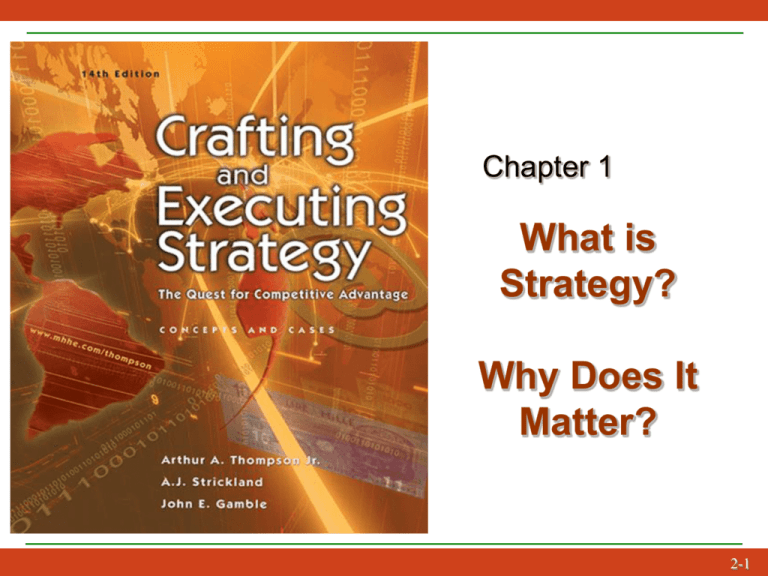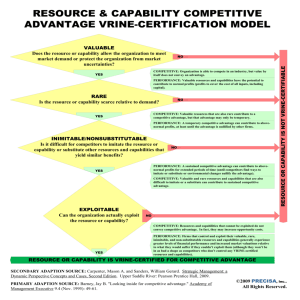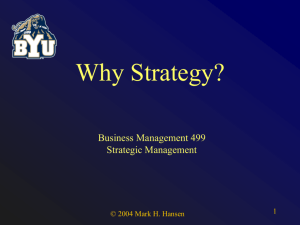Chapters 1 and 2
advertisement

Chapter 1 What is Strategy? Why Does It Matter? 2-1 What Is Strategy? Strategy involves … Time - the present, the future, and the track between Choices – products, markets, services, …. Resources – money, people, tools, etc. Competencies – what we are good at Something that is VRI-O Much more! 1-2 What Is Strategy? Strategy is … The combination of competitive moves and business approaches used by managers to run the company Management’s theory about how to gain competitive advantage – BTW, what’s a theory? A comprehensive plan stating how the firm will achieve its mission and objectives 1-3 What Is Strategy? Strategy is … Management’s “game plan” or, its HOW TO •Attract and please customers •Stake out a market position •Compete successfully •Grow the business •Achieve targeted objectives 1-4 What Is Strategy? Strategy is … The General’s view (Strategos) Integrated Externally oriented Cyclical: Conceptual … Planned … Executed … Reviewed 1-5 Walt Disney Company 1984 Profits: $242 Million Theme Park Operations: 77 percent of profits Consumer Products: 22 percent of profits Filmed Entertainment: 1 percent of profits 1-6 Walt Disney Company Hired Michael Eisner - 1984 1. Increased admission prices at theme parks 1984 - $186 m 1989 - $787 m 2. Focused on movie studios (character development) 1984 - $2.42 m 1994 - $845 m 3. Diversified into television (ABC), hotels, retail stores, sport team, cruise line, publishing, consumer products, licensing, etc. (Huey & McGowan, 1995) Market Cap: 1984 = $2 billion 1994 = $28 billion 1-7 Inferring Strategy A company’s strategy is reflected in what it does and says (see p. 6 of your text) What do you think Eisner’s strategy was? Eisner’s basic theory (strategy) may have been: People will pay a premium price for extraordinary entertainment. We have the necessary resources to create extraordinary entertainment. Therefore, let’s redeploy our resources in a different way and offer something extraordinary to people. 1-8 So Why is Strategy Important? Strategy + Execution = ? Management ! It is management’s job to get results 1-9 Summary Strategy is about creating a desirable future, and it is important because that future is desired. 1-10 But remember … The future is foggy! 1-11 Recommended reading: 1-12 Chapter 2 The Managerial Process of Crafting and Executing Strategy 1-13 The Strategic Management Process External Analysis Mission Strategic Choice Objectives Strategy Implementation Competitive Advantage Internal Analysis 1-14 The Strategic Management Process External Analysis Strategic Choice Objectives Strategy Implementation Competitive Advantage Internal Analysis Mission 1-15 The Strategic Management Process Objectives: • specific, measurable targets, etc. (SMART) • the things a firm needs to ‘do’ to achieve its mission • should influence other elements in the strategic management process See text p. 28 for examples 1-16 The Strategic Management Process External and Internal Analysis Systematic Examination of the Environment External Analysis • interest rates • demographics Internal Analysis • human resources (knowledge) • social trends • manufacturing abilities • technology • technology 1-17 The Strategic Management Process Strategic Choice Internal Analysis External Analysis Strategic Choice Business Level • positioning a business Corporate Level • which businesses? 1-18 The Strategic Management Process Strategy Implementation • how strategies are carried out • who will do what • organizational structure and control • who reports to whom • how does the firm hire, promote, pay, etc. 1-19 The Strategic Management Process Strategy Implementation • every strategic choice has strategy implementation implications • strategy implementation is just as important as strategy formulation (or maybe more so – my view) A Strategy Is Only As Good As Its Implementation 1-20 The Strategic Management Process Competitive Advantage Definition: the ability to create more economic value than competitors External Analysis Mission Strategic Choice Objectives Strategy Implementation Competitive Advantage Internal Analysis • all other elements of the strategic management process are aimed at achieving competitive advantage 1-21 Competitive Advantage The Ability to Create More Economic Value Than Competitors • there must be something different about a firm’s offering vis-à-vis competitors’ offerings • if all firms’ strategies were the same, no firm would have a competitive advantage • competitive advantage is the result of doing something different and/or better than competitors 1-22 Competitive Advantage Two Types of Difference 1) Preference for the firm’s output • people choose the firm’s output over others’ • people are willing to pay a premium Example: Nordstrom 2) Cost advantage vis-à-vis competitors • lower costs of production/distribution Example: Wal-Mart 1-23 Competitive Advantage The Strategic Management Process External Analysis Internal Analysis Strategic Choice Strategy Competitive Implementation Advantage • identify and exploit differences that may lead to competitive advantage Example: Apple’s iPod 1-24 Competitive Advantage Temporary & Sustainable • competitive advantage typically results in high profits • profits attract competition • competition limits the duration of competitive advantage in most cases Therefore, • most competitive advantage is temporary • competitors imitate the advantage or offer something better 1-25 Competitive Advantage Measuring Competitive Advantage Superior Economic Performance Is Viewed as Evidence of Competitive Advantage • it is rather easy to see the evidence of competitive advantage • measuring the source of the advantage per se is typically impossible • it’s difficult to ‘measure’ technology 1-26 Competitive Advantage & The Strategic Management Process Emergent vs. Intended Strategies • the strategic management process leads managers to intended strategies However, • conditions often change or new information becomes available • managers respond and adopt emergent strategies 1-27 The Strategic Management Process Summary This course is not about mere survival, it is about thriving—achieving competitive advantage • the strategic management process helps managers achieve competitive advantage • competitive advantage depends on differences • strategy is about discovering and exploiting these differences 1-28 The Strategic Management Process Applying Strategy to Your Career • a solid understanding of strategy concepts will help set you apart from other job candidates • you can use the process to identify and exploit difference between you and others • you can use the process to determine if you want to stay with a company 1-29 The Strategic Management Process & Competitive Advantage Strategy Matters! Strategy is often the difference between: • success and failure, between mediocrity and excellence • a great manager and average managers • stumbling through life and moving ahead with purpose 1-30






